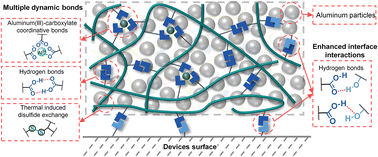Superior stretchable, low thermal resistance and efficient self-healing composite elastomers for thermal management†
Abstract
Thermally conductive polymer-based composites with the combination of superior stretchability, efficient self-healing, recyclability and high thermal conductivity have long been pursued in the modern electronics industry. However, integrating these attractive properties remains challenging due to the complexity of the composite structure and composition. In this work, by fabricating covalent adaptable networks and introducing supramolecular interactions, we prepared a poly(thioctic acid)/aluminum (poly(TA)/Al) composite elastomer. The prevalent supramolecular interactions provide the poly(TA)/Al with enhanced interfacial interaction and a stretchable covalent adaptable network, leading to superior stretchability (1640%), enhanced thermal conductivity (1.83 W mK−1) and excellent self-healing efficiency (96% and 98% at 80 °C for tensile elongation and thermal conductivity, respectively). Moreover, the dynamically reversible covalent adaptable network ensures solid-state plasticity and thermally induced recyclability of the poly(TA)/Al, which can maintain desirable mechanical and thermal conductivity. The current work provides a practical method to design thermally conductive self-healing composites with stretchability and recyclability, which are needed for the heat dissipation of advanced electronic devices.



 Please wait while we load your content...
Please wait while we load your content...